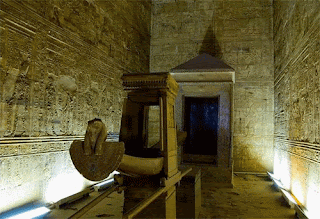Egyptians have believed in the afterlife since prehistoric times. After observing various natural phenomena such as the sun rising as if it was born and setting as if it was dying, then rising again the next day, the Egyptians concluded life and death were extensions of each other. Tomb preparation began long before death occurred. Prayers and food lists were written on tomb walls alongside religious and daily scenes, while furniture and various objects were made and placed within the tomb.
Mummification was essential for a happy afterlife because the ancient Egyptians believed that the mummy housed the soul and spirit. The Ka spirit was the essence of the person, like their double, and it remained in the tomb and made use of the offerings and objects there. The Ba spirit was free to move about. The mummification process took approximately 70 days. The body of the deceased was ritually cleansed and purified. The internal organs were removed and placed in canopic jars, except for the heart. The body of the deceased was carried in a funeral procession of the relatives and friends, as well as professional wailing women to the tomb.
Incantations and offerings allowed the deceased to go safely to the afterworld. The Pyramid Texts, the Book of the Dead, and other religious books were collections of these spells and religious texts. Amulets took various shapes of gods and sacred items, such as the lotus flower and the scarab.
Daily rituals were conducted by temple priests. The high priest of the temple would first wash and then enter the inner temple. After purifying and in front of the god’s statue with burning incense, throwing natron salt, and perfuming it, he would place gems and ornaments on the statue and then make offerings to it. The god's statue was then placed back into the wooden shrine and sealed until the next service.
In the Hellenistic period, Ptolemy the First founded a new religion combining Egyptian and Greek gods so the Greeks and Egyptians would share a deity in common. That new god was called Serapis, for which a temple was built in Alexandria.
Christianity began to spread out through Egypt in the latter half of the first century AD. Christians established unofficial schools for preaching the new religion until it was officially acknowledged in the fourth century AD. Although monasticism spread as individuals sought wisdom in isolation, Saint Antony was a pioneer in establishing the first collective monastic movement.
In the Islamic era, Egypt's contribution to Islam was best shown in the country's spirit of tolerance and broad-mindedness. In other countries, only one religious doctrine was dominant, but in Egypt, the four major Islamic doctrines spread side by side in peace and harmony. A fine spiritual touch was given to religious practices in Egypt, as reflected in the famous Egyptian Sufis, namely Omar Ibn Al-Faridh and Zu Al-Noun Al-Masry. Remote places of worship were dedicated for Sufis in several buildings of the Mamluk era, such as the Khanqah of Sultan Barsbay and the Khanqah of Al-Nasir Farag Ibn Barquq. Egyptians also respected the relatives of the prophet Muhammad and cared for their mosques, even after the Fatimid era ended
Egyptian relics - The Curse of the Pharaohs
- the secret of mummification - Magic at the Pharaohs - Luxor - Sphinx -
Pyramids - The Temple
of Karnak - The Temple of Abu Simbel - Temple of Ramses II - Akhenaten -
Tuthmosis III - Tutankhamun - Pharaoh - Nefertiti - Cleopatra -
Nefertari - Hatshepsut -
.

No comments:
Post a Comment